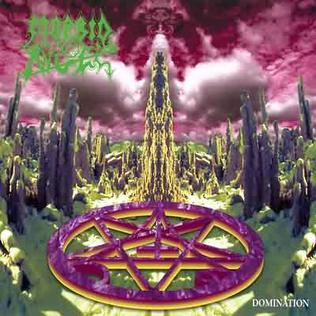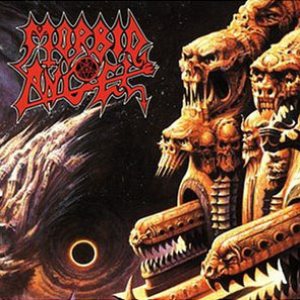Death metal is an extreme subgenre of heavy metal music. It typically employs heavily distorted and low-tuned guitars, played with techniques such as palm muting and tremolo picking; deep growling vocals; aggressive, powerful drumming, featuring double kick and blast beat techniques; minor keys or atonality; abrupt tempo, key, and time signature changes; and chromatic chord progressions. The lyrical themes of death metal may include slasher film-style violence, political conflict, religion, nature, philosophy, true crime and science fiction.

Morbid Angel is an American death metal band based in Tampa, Florida, formed in 1983 by guitarist, primary composer and sole remaining original member Trey Azagthoth, vocalist and bassist Dallas Ward, and drummer Mike Browning. Widely considered one of the most influential bands in the genre and important in the transition of death metal from its thrash metal roots, they were one of the first bands to incorporate guttural vocals, up-tempo blast beats, multiple tempo changes and a dark atmosphere. They have been described as one of "the most influential and emulated bands in death metal", alongside Obituary, Death, Cynic, Autopsy and Deicide, and have been cited as an influence by many later bands. They were also the first death metal band to experience mainstream success in connection with being signed to Giant Records in 1992, heavy rotation of their music videos on MTV, and having the music video for the song "God of Emptiness" shown on an episode of Beavis and Butt-Head. Their first three albums – Altars of Madness (1989), Blessed Are the Sick (1991), and Covenant (1993) – are considered classics in the genre.
Terrorizer is an American grindcore band from Los Angeles, California. It was originally formed in 1985 as Unknown Death by vocalist Oscar Garcia and guitarist Jesse Pintado. They would rename themselves Terrorizer after recruiting drummer Pete Sandoval, who remains the band's sole constant member throughout their discography, in 1986. The band's current lineup consists of Sandoval, bassist David Vincent, vocalist Brian Werner and guitarist Richie Brown. They are currently signed to Earache Records.

Pedro Rigoberto "Pete" Sandoval is a Salvadoran-born American drummer, best known for his work with extreme metal bands like Morbid Angel and Terrorizer.

David Justin Vincent, also known as Evil D, is an American musician who is best known as the former lead vocalist and bassist for the death metal band Morbid Angel, as well as the bassist for Terrorizer and Genitorturers.

Formulas Fatal to the Flesh is the fifth full-length studio album by death metal band Morbid Angel. The Satanic-themed lyrics of previous albums had been replaced with lyrics about the Old Ones, which would become the primary source of Morbid Angel's lyrical content from this point on, and has some lyrical content written in Sumerian. This is the first album to feature singer/bassist Steve Tucker, replacing David Vincent.
Nocturnus, currently Nocturnus AD, is an American death metal band formed in Tampa, Florida, in 1987 by the drummer/vocalist Mike Browning. They were known for their science-fiction themed lyrics and use of keyboards, both of which were virtually unknown in extreme metal at the time. The 1990 debut from the band is considered by some to be the first progressive death metal album.

Blessed Are the Sick is the second studio album from American death metal band Morbid Angel. Though the album features some fast sections, the overall sound is markedly slower than the debut and with identifiable classical music undertones present. Tracks 9, 10 and 12 are re-recorded songs from the 1986 demo Abominations of Desolation.

Altars of Madness is the debut studio album by American death metal band Morbid Angel, released on May 12, 1989, by Combat Records/Earache Records. The album was recorded in December 1988 at Morrisound Recording in Tampa, Florida. The album is one of the earliest examples of death metal and is considered to have helped pioneer the sound along with Possessed's Seven Churches in 1985 and Death's Scream Bloody Gore in 1987, and set a new precedent for heaviness and extremity, both musically and lyrically. It is one of the most celebrated albums in death metal, and one of the most influential heavy metal albums of all time.

Abominations of Desolation is the demo album by American death metal band Morbid Angel. While it was originally recorded in May 1986, the band did not release it at the time due to their dissatisfaction with the final product. These recordings would later be released in 1991 at the decision of the band's record label, Earache Records.

Domination is the fourth full-length studio album by death metal band Morbid Angel, released in 1995. This was Morbid Angel's last album under the label Giant Records before the label dropped the band. The band then re-signed with their former label, Earache Records. This is also the first Morbid Angel album to feature Hate Eternal frontman Erik Rutan on guitars and keyboards, who later left the band following this album, though he would return to the band for Gateways to Annihilation.

Gateways to Annihilation is the sixth studio album by the death metal band Morbid Angel.

Heretic is the seventh studio album by the Florida death metal band Morbid Angel. This would be their last under Earache Records, as the band decided not to renew its contract, and also the last to feature Pete Sandoval and with Steve Tucker until his return on 2017's Kingdoms Disdained.

Seven Churches is the debut studio album by American death metal band Possessed. The album title refers to the Seven Churches of Asia mentioned in the Book of Revelation. "The Exorcist" begins with producer Randy Burns' version of Mike Oldfield's Tubular Bells, performed as it was in the 1973 horror film of the same name. Seven Churches is widely regarded as the first death metal album to exist, and About.com named it one of the ten essential albums of the genre. Jeff Becerra and Larry Lalonde were only 16 when the album was recorded.

Enter the Grave is the debut album by the English thrash metal band Evile. Released on 27 August 2007 in Europe and on 25 September in North America and Japan, the album received generally favorable reviews and entered the UK Rock Chart at number 33. It was produced by Flemming Rasmussen and recorded at Sweet Silence Studios, Copenhagen, Denmark. Rasmussen had produced three Metallica albums, which raised the profile of the album's release. The track "Thrasher" was included on the 2008 Earache Thrash Pack, a downloadable selection of songs for the music video console game Rock Band.
Michael George Browning is an American heavy metal drummer and vocalist.

Illud Divinum Insanus is the eighth studio album by American death metal band Morbid Angel. It was released on June 7, 2011, by independent French record label Season of Mist. It is Morbid Angel's first album since Heretic (2003), the band's longest gap to date between studio albums. This is the only Morbid Angel album to feature guitarist Destructhor and drummer Tim Yeung, making it their first not to feature Pete Sandoval, who was recovering from surgery. It is also the band's only album to feature bassist/vocalist David Vincent since he rejoined in 2004.
Florida death metal is a regional scene and stylistic subdivision of death metal. Some of the most significantly pioneering and best-selling death metal acts emerged in Florida, especially in the Tampa Bay area. As a result, Tampa is unofficially known by many death metal fans as the "capital of death metal." The scene coalesced in the mid-1980s through early 1990s around the output of bands such as Death, Nasty Savage, Deicide, Monstrosity, Morbid Angel, Atheist, Obituary, and others. The producer Scott Burns and the studio Morrisound Recording were also instrumental in developing and popularizing the Florida scene. Some bands which originated outside of Florida, such as Malevolent Creation and Cannibal Corpse, relocated to the state in order to participate in this burgeoning scene. The Florida bands featured a more technical approach to the evolving death metal sound, a style which spread beyond the confines of the state, and some were instrumental in creating the progressive death metal subgenre. The death metal genre as a whole, including the Florida scene, declined in popularity in the second half of the 1990s, but many bands within the Florida scene persisted and the scene resurged in popularity in subsequent decades.

Kingdoms Disdained is the ninth studio album by American death metal band Morbid Angel, which was released on December 1, 2017 by Silver Lining Music. It is the first album since 2003's Heretic to feature Steve Tucker and the only one to feature former Abysmal Dawn drummer Scott Fuller. It is also the first to not feature David Vincent, Destructhor and Tim Yeung since 2011's Illud Divinum Insanus, as all three members left the band in 2015. A music video was made for "Garden of Disdain".














